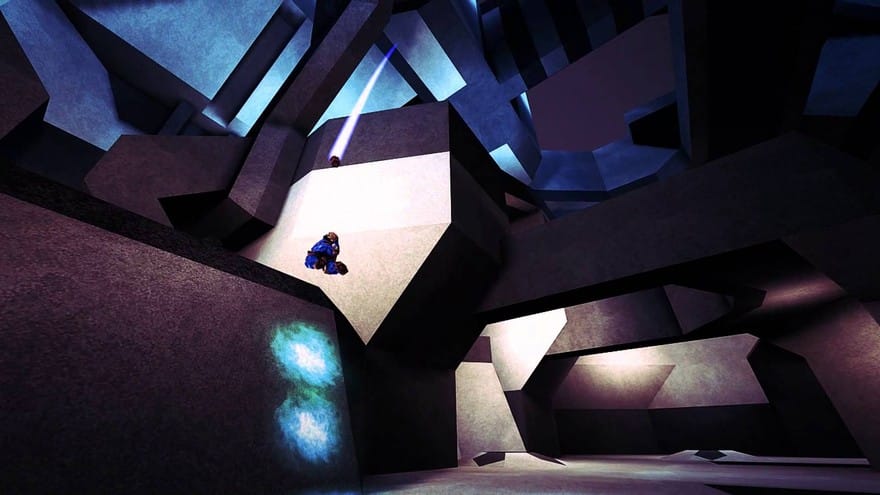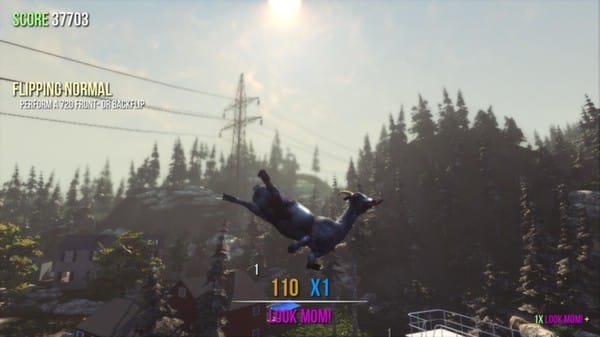How a group of players cracked open Quake 3 and found a new way to play

I came across my first trickjump compilation around 2007. Although many first-person shooters have their own devoted communities of trickjumping, the compilation I first saw was for Quake 3—a game that I had played many times with roommates and friends at LAN parties we used to host in Chicago. The video, like many trickjump compilations, showed a group of players flying across maps and careening around corners. Trickjumping combined a strategy of strafe-jumping and self-inflicted propulsion. In other words, a trick might require using a rocket launcher to push yourself forward, or give yourself an extra lift, since the impact of the rocket would change your trajectory and speed. In Quake 3, chaining together rockets, grenades, and plasma pulses can radically increase a player’s speed. Using these techniques, players could traverse a map in a fraction of the time it would normally take.
As this style of play spread, and compilation videos spread through the chat client IRC and various forums, the Quake 3 modding community built custom maps with tricking in mind. In 2000, a group of programmers and designers released a trick map modification package called DeFRaG that pushed forward the genre of trickjumping, solidifying it as a central play-style within the overall Quake 3 community. Like many other curious hackers and hobbyist electronic engineers that paved the way for maker culture to emerge, these early modders created a tool that would influence an entire generation of creative play. The mod was centered around showing players how they could use the existing Quake engine to create chains of movements and actions that could break or undermine the limitations of the software. A popular technique within all Quakebuilt games is called strafe-jumping, a way of moving in air that breaks the built-in limitations of the game engine. DeFRaG not only showed players how to complete these essential tricks, it also provided a heads-up-display (HUD) that showed players graphical feedback of their movements and speed.
Exploiting the physics engine was quickly adopted by many freestylers.
The history of tricking in Quake 3 is closely tied with its initial release, and exploiting the physics engine was quickly adopted by many freestylers in the built-in maps. Although DeFRaG initiated a kind of outreach modification to give trickers a toolkit for perfecting their air strafes and bunny-hopping. The method of rocket jump tricks had dated back to earlier first-person shooters developed by iD, but according to player Nihilanth, but it wasn’t until Mario “b3nt” Cifaldi started releasing compilations on the “Space (Quake 3CTF4)” map around 2001. Nihilanth told me that compilations had most likely existed and circulated before this, but he distinctly remembers b3nt’s compilations informing many early adopters.
When talking with Justin Sanchez, formerly of trickjumping group Team Event Horizon, we discussed how the communities quickly formed and supported one another through the distribution of compilations and congenial competitiveness. From Overdrive PC forum threads and IRC chatrooms, comps would quickly become a source of fascination amongst a variety of players. Nihilianth attributed the distribution and spread of tricking to the fact that broadband internet was becoming more popular at home. As a result, players not only could start to distribute their videos more easily, but entire communities of collaborative teams became more common.
Due to the influx of players coming to trickjumping (and the growing number of players having access to high speed internet), new methods for tricking and experimentation with the mechanics of the engine emerged. Though some of these techniques were fueled by meticulous practice on community-designed custom maps, some players started to implement scripted sequences and use the precision of coded bot behavior to create incredibly intricate tricks. This scripting became a point of contention within the tricking community, and some players argued that using bots and code for new comps went against the purity of a trick made “by hand.”

It was around this time that Sanchez decided to form his team with some other players to provide an outlet for new players to join in the fun without the use of bots. By forming a team rooted in collaboration and openness Sanchez hoped to avoid the aggressive sense of competition that sometimes accompanies online gaming. Sanchez and Team Event Horizon would invite observers could watch them practice and perform tricks. Although this gesture created and sustained a sense of collaboration, many members of the team, including Sanchez, started to move on from tricking around the late 00s partially as a result of graduating from undergrad and starting full time work. Team Event Horizon continues to work on new compilations, and Sanchez commented that he still occasionally checks in with the group and lends a hand editing every now and then.
Even though that scene receded, the legacy of the trickjumping community can be seen in contemporary games. A generation of game developers directly employ community creativity, map sharing, collaborative expression, and supporting players modifying and experimenting with their engines. In the past five years in particular, an entire sub-genre of trickjumping games has emerged. These games borrow from the niche community of trickjumping in a way that highlights player creativity, community collaboration, and experimental game engine mechanics.
One notable example is Coffee Stain studio’s Goat Simulator. Though this title directly borrows from a trickjumping ethos of community-based collaboration and experimental gameplay, it does so in a deliberate way. The subversive gesture of trickjumping within Quake 3 is incorporated into a centralized component of generating achievements within Goat Simulator. Though this title is responding more to the faulty—and often hilarious—physics engines that have come to dominate simulation-based games, Goat Simulator also suggests that player creativity and the absence of explicit narrative goals is appealing as a game all on its own. Instead of having to bend the engine of an existing game to the limits of its performance, Goat Simulator gives you these extremes right out of the box.
The legacy of the trickjumping community can be seen in contemporary games.
The community efforts of building, designing, and releasing Goat Simulator show a side of collaborative creativity at the point of development, but games like Trials Fusion and Track Mania2 illustrate player experimentation within the game engine. Both games employ the sharing of custom maps that experiment with the physics and design of the game—and both do so as a feature, as opposed to a flaw. Track Mania2’s relatively simplistic mechanics and unrealistic mid-air maneuvering are a deliberate part of track creation for players. As a result, a common style of custom maps distributed within this community are called “Press Forward” of PF. In this type of track, all players have to do is continuously hold down the accelerator and the game engine will do the rest. Most PF tracks employ a complex variety of timed events that flip the player in various directions based on the way the car mechanics are designed to react to midair collisions and grip of different surfaces. Track Mania2 user vossi84’s map eXtra large is a hypnotizing example of PF ingenuity, sending the player through a barrage of obstacles and freefalls that show a deep understanding of level design and game mechanics.
Looking at the combination of Goat Simulator and games like Track Mania2 provide an insight into the ways that the history of trickjumping and the activity of collaborative creativity within a game environment can influence contemporary designers. What may have been lost, though, is the general inquisitiveness of players to push the boundaries of a game’s mechanic in order to foster a new community. Spintires has fostered a small collective of players experimenting with the ways in which winching different vehicles together creates humorous glitches in the physics engine. However, the compilations of this glitch are not creating an identity and gameplay style wholly separate or unique from the overall intention of the game, the way that trickjumping did.

Part of what has been lost between Quake 3 and contemporary titles can be attributed to the overall increase of technical and narrative sophistication found within contemporary games. However, with this increased sophistication comes less opportunity for players themselves to carve out niche communities of creative collaboration. As a result, whenever players do find ingenious ways of manipulating the game in more recent titles, they are considered griefers or trolls. Team Fortress 2 is a notable example of players finding exploits within early releases of buggy maps, utilizing those bugs for creative expression. That being said, finding exploits and utilizing unique aspects of a game engine often get celebrated in world record speed runs recorded and distributed through twitch.tv. For developers and players alike, looking at trickjumping in Quake 3 might provide an insightful balance between griefing and prescriptive play in order to foster creative communities of experimental gameplay.



